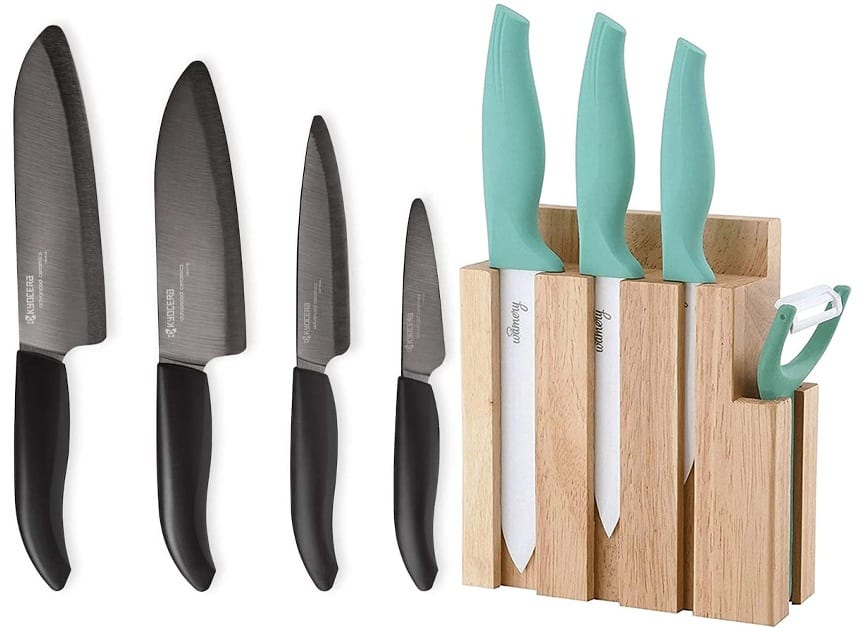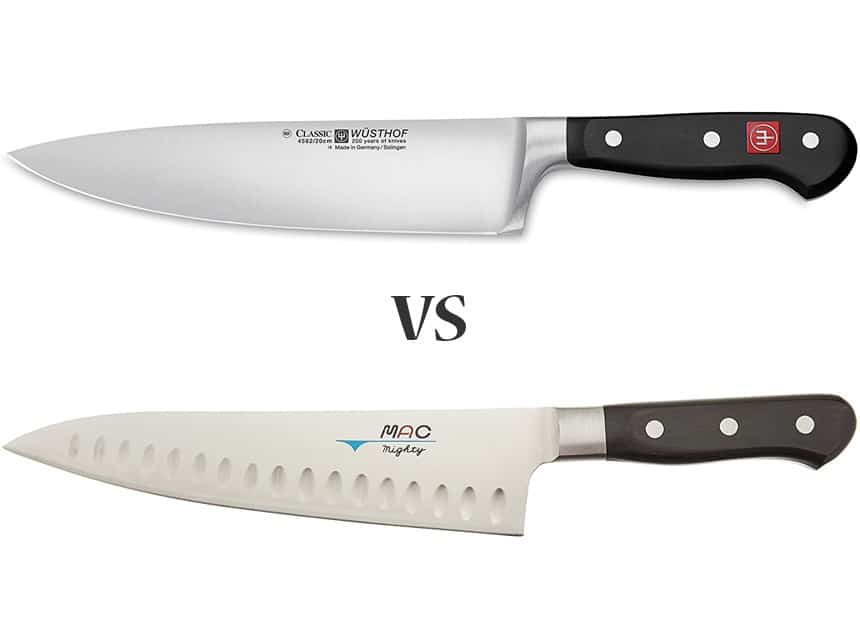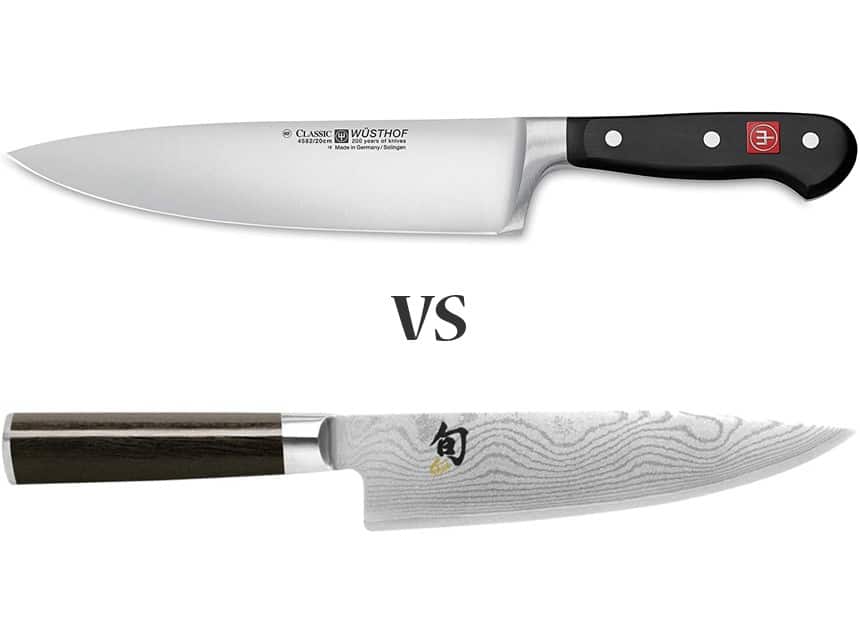
Ceramic knives are safer because they are sharp and stay sharper for longer, due to ceramic being harder than steel. Accidents happen more frequently when knives are dull because they are more likely to slip. A sharp knife will cut effortlessly into the food and so the chances of slippages and accidents occurring reduce. They are also far lighter which makes them easier to handle.
To learn a little bit more about what makes ceramic knives so much safer than their metal counterparts we’ve put together this detailed guide.
Looking for a ceramic knife set?
You can check out my recommended Kyocera ceramic knife set on Amazon here (opens new tab).
Are ceramic blades safer than steel?
Ceramic blades have a couple of different things going for them compared to steel knife blades, but the reason that ceramic blades are so much safer has to do with the edge that ceramic blades hold.
You see, the old adage that “a dull knife is more dangerous than a sharp knife” is 100% true.
In fact, there are few things as dangerous as trying to cut and work with a knife that has lost its edge.
You end up pushing through material rather than slicing through material. You end up hacking and chewing on materials you want to cut easily. It just creates a real unsafe kind of situation. Ceramic blades don’t have that problem.
These blades have extreme levels of hardness, have blades that won’t rust, and have blades that require next to no maintenance whatsoever to maintain their razor edge.
Why are sharper knives safer?
Knives that are razor-sharp are always safer than dull knives.
A sharp knife slices. A dull knife grabs and pulls so the cuts won’t be as straight or as smooth.
When you pick up a knife you expect it to have a razor-sharp edge, an edge that is going to slice and dice whatever it is you are attempting to cut.
If you pick up a knife and start to cut with it, only to realize too late that the knife blade itself is dragging, is pulling and tearing, and generally just causing a lot more headache than it is worth you end up in a pretty unsafe situation.
If, on the other hand, you pick up a knife and it is razor-sharp you’re going to be able to get through your task at hand in record time.
You know the blade is sharp (so you know to stay careful with it) but you’re also able to make quick and accurate cuts that are going to slip, slide, or cause any issue.
Are lighter knives safer?
Lighter knives are also generally safer to use than heavy knives for a couple of different reasons.
For starters, a lighter knife is a lot easier to move, maneuver, and get into position when you are ready to make your cuts.
You don’t have to feel like you are fighting a big boat of a blade every time you need to make a slice. Instead, it’s just a quick flick of your wrist and you are making the kinds of cuts you want to make – all with a lot of control and all with a lot of intentionality.
Secondly, you don’t have to worry about fatigue as much as you would have had to worry about with a heavier blade.
If you are cutting only a handful of onions every now and again it probably doesn’t matter how heavy your knife blade is.
If, on the other hand, you are chopping up a lot of ingredients on a regular basis you’re going to notice an extra ounce of weight here and there. Your hand is going to fatigue, your arm is going to fatigue, and you are going to get a lot sloppier with your cuts because of it.
What can happen if you work with a blunt knife?
A blunt knife is going to want to push back against you every time you go to make a cut.
Instead of quickly slicing through things (like a hot knife through butter) you’re instead going to be putting all of your force into the knife and trying to muscle it through. That’s a recipe for disaster.
Secondly, blunt knives generally have sharp “hotspots” next to the blunter areas.
This means you’ll be cutting through something as intended for a second before grabbing and tearing before redirecting and then starting to cut all over again. The end result is a mess – a real dangerous mess!
It doesn’t take much for a blunted knife to slip and skip off of the thing that you are cutting and then sink itself into your support hand, your arm, the table, or something other than what you intended to cut.
Can ceramic knives cut skin?
Ceramic knives certainly can cut skin, they are razor-sharp after all! One of the big advantages of using a ceramic knife is that it is so sharp and that it maintains its edge for so long.
This is definitely something you want to be aware of scooping up a ceramic knife. While it is safer because it holds and edge and stays sharp for longer that doesn’t mean that it is never going to cut you.
Like all knives you need to treat this ceramic material with respect. You need to be careful and safe with your ceramic blade.
Do you need to sharpen a ceramic knife?
The overwhelming majority of ceramic knives do not have to be sharpened anywhere near as often as traditional steel blades will.
That being said, eventually the edge of your ceramic knife will go dull and it will have to be touched up just the same way as any other cutting instrument.
You’ll need to be sure that you are using a ceramic knife sharpening kit to get the job done right, though. The knife sharpening set up that you are using right now for traditional steel blades isn’t going to “cut the mustard”, so to speak.
Search for a special ceramic sharpening kit, learn to use it properly, or simply toss the old ceramic knife and upgrade with a new one when the blade starts to get dull.
What should you not cut with a ceramic knife?
There are a couple things you want to steer clear of when using your ceramic knife, including (but not limited to):
- Frozen foods
- Anything hard like a bone
- Anything that involves jiggling or wiggling a blade that can break bits of ceramic off inside your food
Ceramic is hard but it’s also brittle. That means it’s much easier to chip a ceramic blade in comparison with steel.
You certainly shouldn’t try and use your ceramic knife blade as a prybar, as a screwdriver, or as a common household tool the way you might with more traditional steel blades, either.

